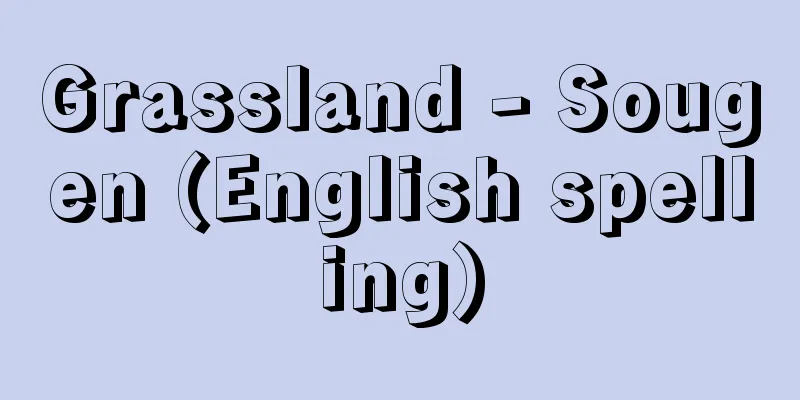Udonga - Udonge

|
〘Noun〙 (Abbreviation of "Udonharage (Udonparaka)") 1. A type of fig in the Mulberry family. Native to India, distributed in the Himalayas, India, Ceylon, etc. The leaves are oval with pointed tips, 10-18cm long. The flowers are small, enclosed in a pot-shaped receptacle and cannot be seen from the outside. The fruits are obovate, about 3cm long, and are edible, and the leaves are used as feed for livestock. In Buddhism, as the flowers cannot be seen by humans, their blooming is seen as an auspicious sign, and the sutras say that they bloom once every 3,000 years. It is said that when they bloom, the Wheel- Turning King will appear. Auspicious flower. A flower that arises from the sky. A rare flower. Udonge flower. Udongebana. ※Utsubo (c. 970-999), Naishi no Kami: "That elixir of immortality is not inferior to udonge." [Hokke Mongu - vol. 4] ② Used as an analogy for something that is difficult to encounter with the Buddha, or something that is generally extremely rare. Udonharage . Udongebana. ※Toraakirahon Kyogen - Hanako (late Muromachi - early modern period): "It was a coincidence that it was an afukosoudonge, but first I'll lay a sasa wo maire toiu futena." ③ A popular name for the eggs laid by the lacewing insect on other objects. The eggs are attached to the end of a white, thread-like stalk about two centimeters long, and are laid in a cluster in one place, so they look like flowers. They can be found on the branches and leaves of plants, as well as on the ceilings of houses, and are considered to be a sign of good or bad luck. Udonge flower. Season: Summer. *Fire Island (1939) by Nakamura Kusadao: "The udonbana flower will never again be in a quiet state." (In Japan, it is called this because it rarely blooms.) Another name for the plant "Basho." *Azuma Kagami - July 9, 1223 (2nd year of the Jo-o era): "It is said that the udonbana flower has bloomed. (Omitted) It is said that the basho flower is the flower ." Another name for "fig." [Revised Edition of the Honsho Komoku Keimo (1847)] Source: The Selected Edition of the Japanese Language Dictionary About the Selected Edition of the Japanese Language Dictionary Information |
|
〘名〙 (「うどんはらげ(優曇波羅華)」の略)① クワ科のイチジク属の一種。インド原産で、ヒマラヤ、インド、セイロン島などに分布。葉は長さ一〇~一八センチメートルの先がとがった楕円形。花は小形で壺状の花托に包まれ、外からは見えない。果実は長さ約三センチメートルの倒卵形で食用となり、葉は家畜の飼料となる。仏教では、花が人の目に触れないため、咲いたときを瑞兆とみ、経典には三千年に一度咲くと伝える。咲くときは転輪聖王(てんりんじょうおう)が出現するという花。霊瑞華。空起花。希有花。うどんげの花。うどんげばな。※宇津保(970‐999頃)内侍督「かの不死薬、うどんげに劣らざらん」 〔法華文句‐四上〕② 仏にあいがたいことや、一般にきわめてまれなことのたとえに用いる。優曇波羅華(うどんはらげ)。うどんげばな。※虎明本狂言・花子(室町末‐近世初)「たまたまあふこそうどんげなれ、まづまづささをまいれといふてな」③ 昆虫のクサカゲロウが他の物に産みつけた卵の俗称。二センチメートルくらいの白い糸状をした柄の先に丸い卵をつけたものを、一箇所にかためて産みつけるので、花のように見える。草木の枝や葉などのほか、家の天井などにも見られ、吉凶の前兆とされる。うどんげのはな。《季・夏》※火の島(1939)〈中村草田男〉「優曇華やしづかなる代は復(また)と来まじ」④ (日本ではまれに花が咲くところからいう) 植物「ばしょう(芭蕉)」の異名。※吾妻鏡‐貞応二年(1223)七月九日「優曇花開敷之由風聞。〈略〉芭蕉花歟之由申レ之」⑤ 「いちじく(無花果)①」の異名。〔重訂本草綱目啓蒙(1847)〕
出典 精選版 日本国語大辞典精選版 日本国語大辞典について 情報 |
<<: Powdery mildew - Powdery mildew
>>: Udon - Udon (English spelling)Jean-Antoine Houdon
Recommend
Osaka Kaidou
…The Osarizawa mine was taken over by the Nanbu c...
Kushashu
...A group of scholars who studied and lectured o...
Sargeson - Frank Sargeson
New Zealand novelist and short story writer. Born...
Kanroji family
The main line of the Kajiyuji family, Northern Bra...
Atherix fontenalis (English spelling) Atherix fontenalis
…Although they are closely related to the Tabanid...
Jokhang Temple - Jo Bo Khang (English spelling)
The name of a Tibetan temple. It is also written a...
Oppenheimer, E. - Oppenheimer is here!
…Headquarters: Johannesburg. Founded in 1917 by E...
kleśa (English spelling) klesa
…The original Sanskrit word kleśa is the noun for...
Expected Gain - Kitairieki
...Therefore, the payoffs in this case are as sho...
Cole, H.
...Thomas Bewick (1753-1828) used woodblocks to b...
Jilin - Shunei
A municipal district in the central Inner Mongoli...
Illigera luzonensis (Presl) Merr.
An evergreen, woody vine of the family Laminaceae....
The Museum of Modern Art, Kamakura & Hayama
Located in Kamakura City, Kanagawa Prefecture and...
Nakagawa Mikuriya - Nakagawa Mikuriya
The Mikuriya was a part of the Ise Grand Shrine te...
Korean Bell
A temple bell cast in Korea from around the Silla ...









